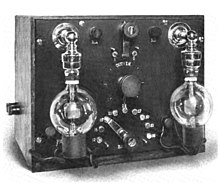Electronics has hugely influenced the development of modern society.
History and development[edit]
Electronics has hugely influenced the development of modern society. The identification of the electron in 1897, along with the subsequent invention of the vacuum tube which could amplify and rectify small electrical signals, inaugurated the field of electronics and the electron age.[1] Practical applications started with the invention of the diode by Ambrose Fleming and the triode by Lee De Forest in the early 1900s, which made the detection of small electrical voltages such as radio signals from a radio antenna possible with a non-mechanical device.
Vacuum tubes (Thermionic valves) were the first active electronic components which controlled current flow by influencing the flow of individual electrons,[2] They were responsible for the electronics revolution of the first half of the twentieth century,[3][4] They enabled the construction of equipment that used current amplification and rectification to give us radio, television, radar, long-distance telephony and much more. The early growth of electronics was rapid, and by the 1920s, commercial radio broadcasting and communications were becoming widespread and electronic amplifiers were being used in such diverse applications as long-distance telephony and the music recording industry.
The next big technological step took several decades to appear, when the first working point-contact transistor was invented by John Bardeen and Walter Houser Brattain at Bell Labs in 1947.[5] However, vacuum tubes played a leading role in the field of microwave and high power transmission as well as television receivers until the middle of the 1980s.[6] Since then, solid-state devices have all but completely taken over. Vacuum tubes are still used in some specialist applications such as high power RF amplifiers, cathode ray tubes, specialist audio equipment, guitar amplifiers and some microwave devices.
In April 1955, the IBM 608 was the first IBM product to use transistor circuits without any vacuum tubes and is believed to be the first all-transistorized calculator to be manufactured for the commercial market.[7][8] The 608 contained more than 3,000 germanium transistors. Thomas J. Watson Jr. ordered all future IBM products to use transistors in their design. From that time on transistors were almost exclusively used for computer logic and peripherals. However, early junction transistors were relatively bulky devices that were difficult to manufacture on a mass-production basis, which limited them to a number of specialised applications.[9]
You received this message because you are subscribed to the Google Groups "2top-manitotasy-1" group.
To unsubscribe from this group and stop receiving emails from it, send an email to 2top-manitotasy-1+unsubscribe@googlegroups.com.
To view this discussion on the web visit https://groups.google.com/d/msgid/2top-manitotasy-1/CALML-R3_DU9qqQFzeM8%2BWSS0L1LHc09XGotQuJCpzeZBD-ZuiA%40mail.gmail.com.


Comments
Post a Comment